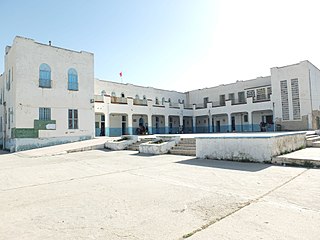This article has an unclear citation style.(January 2017) (Learn how and when to remove this template message) |
Coordinates: 36°27′N8°40′E / 36.45°N 8.66°E Touccabeur, known in ancient times as Thuccabora, is a railway town and archaeological site in northern Tunisia. It is located in the Medjerda valley, outside of Bou Salem. Touccabeur is located in the Medjerda valley at 36.45N, 8.66E, outside of Bou Salem. [1]

A geographic coordinate system is a coordinate system that enables every location on Earth to be specified by a set of numbers, letters or symbols. The coordinates are often chosen such that one of the numbers represents a vertical position and two or three of the numbers represent a horizontal position; alternatively, a geographic position may be expressed in a combined three-dimensional Cartesian vector. A common choice of coordinates is latitude, longitude and elevation. To specify a location on a plane requires a map projection.

A railway town, or railroad town, is a settlement that originated or was greatly developed because of a railway station or junction at its site.

Tunisia (officially the Republic of Tunisia) is a country in the Maghreb region of North Africa, covering 165,000 square kilometres. Its northernmost point, Cape Angela, is the northernmost point on the African continent. It is bordered by Algeria to the west and southwest, Libya to the southeast, and the Mediterranean Sea to the north and east. Tunisia's population was 11.435 million in 2017. Tunisia's name is derived from its capital city, Tunis, which is located on its northeast coast.
In antiquity, Thuccabora was a Roman – Berber civitas in the province of Africa Proconsularis. The stone ruins of the city lie near the modern town, and include inscriptions from the reign of Commodus. [2]

The Roman Empire was the post-Roman Republic period of the ancient Roman civilization. It had a government headed by emperors and large territorial holdings around the Mediterranean Sea in Europe, North Africa, and West Asia. From the constitutional reforms of Augustus to the military anarchy of the third century, the Empire was a principate ruled from the city of Rome. The Roman Empire was then divided between a Western Roman Empire, based in Milan and later Ravenna, and an Eastern Roman Empire, based in Nicomedia and later Constantinople, and it was ruled by multiple emperors.

Berbers, or Amazighs are an ethnic group of several nations indigenous to North Africa.

In the history of Rome, the Latin term civitas, according to Cicero in the time of the late Roman Republic, was the social body of the cives, or citizens, united by law. It is the law that binds them together, giving them responsibilities (munera) on the one hand and rights of citizenship on the other. The agreement (concilium) has a life of its own, creating a res publica or "public entity", into which individuals are born or accepted, and from which they die or are ejected. The civitas is not just the collective body of all the citizens, it is the contract binding them all together, because each of them is a civis.
Inscriptions from the reign of Commodus. [3] During the Roman Empire Thuccabora was the seat of an ancient bishopric which survives today as a titular see of the Roman Catholic Church. [4]

Commodus, born Lucius Aurelius Commodus and died Lucius Aelius Aurelius Commodus, was Roman emperor with his father Marcus Aurelius from 177 to his father's death in 180, and solely until 192.

A cathedra or bishop's throne is the seat of a bishop. It is a symbol of the bishop's teaching authority in the Catholic Church, the Orthodox Church, and the Anglican Communion churches. Cathedra is the Latin word for a chair with armrests, and it appears in early Christian literature in the phrase "cathedrae apostolorum", indicating authority derived directly from the apostles; its Roman connotations of authority reserved for the Emperor were later adopted by bishops after the 4th century. A church into which a bishop's official cathedra is installed is called a cathedral.
A titular see in various churches is an episcopal see of a former diocese that no longer functions, sometimes called a "dead diocese".











